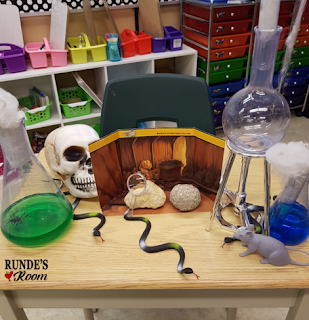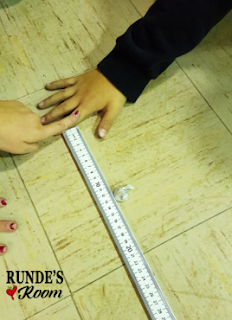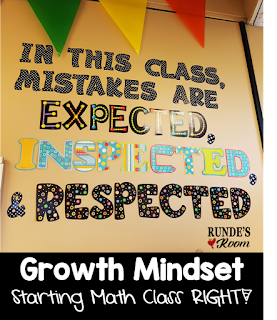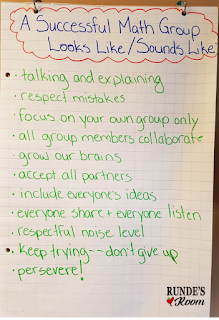Mad Scientist Day! This is seriously one of the best days of the year in my classroom! As a class, my students have the opportunity to earn points for excellent behaviour and excellent learning - with the points going towards earning extra excellent learning days!!! Mad Scientist Day is our first one of the year.
This is my second year doing Mad Scientist Day. This year I switched up the activities a bit. Last year we had Mad Scientist Day the day before Halloween, so our activities were very Halloween based. This year, that wouldn't have worked. All of our activities are aligned with the science strands we study during the year, so they have a little information to draw from when we get to the particular units.
I "set the stage to engage" first. A fun costume and a few props did the trick - something quick and easy to set up. Students were also invited to dress up as Mad Scientists for the day.

Our first activity was a STEM activity for making catapults (tie in to Simple Machines - levers). I divided my class into small groups and gave each group a plastic spoon, two popsicle sticks and masking tape. They were also allowed to use anything in their desks. Last year, before Halloween, I had small plastic rats to use as the load and we called our catapults, "ratapults". This year we used hershey kisses and "chucked chocolate". I gave them around 15 minutes to build their catapults. Once we were done, we had a chucking chocolate competition. Students had to measure the distance they could "chuck their chocolate" in metres and centimetres. Each group had 3 attempts, and then we compared and ordered the distances (YAY for a math tie-in!!!).
 Next, the little Mad Scientists got to smash some rocks - cracking open geodes for our tie-in to Rocks and Minerals. I bought some geode kits from Amazon (affiliate link to the product below). This was definitely the WOW activity for the students. It definitely took some time to get through the whole class, so I used the time to take some awesome pictures of my students dressed as mad scientists sitting behind the prop desk.
Next, the little Mad Scientists got to smash some rocks - cracking open geodes for our tie-in to Rocks and Minerals. I bought some geode kits from Amazon (affiliate link to the product below). This was definitely the WOW activity for the students. It definitely took some time to get through the whole class, so I used the time to take some awesome pictures of my students dressed as mad scientists sitting behind the prop desk.
 As we completed each activity, students worked in a little Mad Scientist booklet I made for the day (the AWESOME clip art was part of the Mad Scientist Set by Melonheadz Illustrating - you can see it HERE). For each activity we had to fill in "What we Did" and "What we Learned". You can download a copy of this booklet I made HERE (just a note - it's not editable if you are doing different activities, but it can definitely serve as inspiration).
As we completed each activity, students worked in a little Mad Scientist booklet I made for the day (the AWESOME clip art was part of the Mad Scientist Set by Melonheadz Illustrating - you can see it HERE). For each activity we had to fill in "What we Did" and "What we Learned". You can download a copy of this booklet I made HERE (just a note - it's not editable if you are doing different activities, but it can definitely serve as inspiration).
 Next up was Making Blood Models (tie in to Human Body unit). I've blogged about this as a full lesson before - you can see this blog post HERE. Each student had a water bottle. We added a drop of yellow food coloring to the water for the plasma. Then we added cheerios (dyed red with a full bottle of food dye) for the red blood cells. Mini marshmallows were added for the white blood cells, and we used small circles of paper from the hole punch for platelets. We watched a Brainpop video on blood before we made our models to further our learning. The students LOVE this one!
Next up was Making Blood Models (tie in to Human Body unit). I've blogged about this as a full lesson before - you can see this blog post HERE. Each student had a water bottle. We added a drop of yellow food coloring to the water for the plasma. Then we added cheerios (dyed red with a full bottle of food dye) for the red blood cells. Mini marshmallows were added for the white blood cells, and we used small circles of paper from the hole punch for platelets. We watched a Brainpop video on blood before we made our models to further our learning. The students LOVE this one!
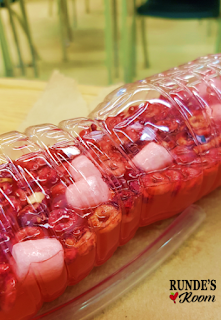
4
This is my second year doing Mad Scientist Day. This year I switched up the activities a bit. Last year we had Mad Scientist Day the day before Halloween, so our activities were very Halloween based. This year, that wouldn't have worked. All of our activities are aligned with the science strands we study during the year, so they have a little information to draw from when we get to the particular units.
I "set the stage to engage" first. A fun costume and a few props did the trick - something quick and easy to set up. Students were also invited to dress up as Mad Scientists for the day.

Our first activity was a STEM activity for making catapults (tie in to Simple Machines - levers). I divided my class into small groups and gave each group a plastic spoon, two popsicle sticks and masking tape. They were also allowed to use anything in their desks. Last year, before Halloween, I had small plastic rats to use as the load and we called our catapults, "ratapults". This year we used hershey kisses and "chucked chocolate". I gave them around 15 minutes to build their catapults. Once we were done, we had a chucking chocolate competition. Students had to measure the distance they could "chuck their chocolate" in metres and centimetres. Each group had 3 attempts, and then we compared and ordered the distances (YAY for a math tie-in!!!).
 Next, the little Mad Scientists got to smash some rocks - cracking open geodes for our tie-in to Rocks and Minerals. I bought some geode kits from Amazon (affiliate link to the product below). This was definitely the WOW activity for the students. It definitely took some time to get through the whole class, so I used the time to take some awesome pictures of my students dressed as mad scientists sitting behind the prop desk.
Next, the little Mad Scientists got to smash some rocks - cracking open geodes for our tie-in to Rocks and Minerals. I bought some geode kits from Amazon (affiliate link to the product below). This was definitely the WOW activity for the students. It definitely took some time to get through the whole class, so I used the time to take some awesome pictures of my students dressed as mad scientists sitting behind the prop desk. As we completed each activity, students worked in a little Mad Scientist booklet I made for the day (the AWESOME clip art was part of the Mad Scientist Set by Melonheadz Illustrating - you can see it HERE). For each activity we had to fill in "What we Did" and "What we Learned". You can download a copy of this booklet I made HERE (just a note - it's not editable if you are doing different activities, but it can definitely serve as inspiration).
As we completed each activity, students worked in a little Mad Scientist booklet I made for the day (the AWESOME clip art was part of the Mad Scientist Set by Melonheadz Illustrating - you can see it HERE). For each activity we had to fill in "What we Did" and "What we Learned". You can download a copy of this booklet I made HERE (just a note - it's not editable if you are doing different activities, but it can definitely serve as inspiration). Next up was Making Blood Models (tie in to Human Body unit). I've blogged about this as a full lesson before - you can see this blog post HERE. Each student had a water bottle. We added a drop of yellow food coloring to the water for the plasma. Then we added cheerios (dyed red with a full bottle of food dye) for the red blood cells. Mini marshmallows were added for the white blood cells, and we used small circles of paper from the hole punch for platelets. We watched a Brainpop video on blood before we made our models to further our learning. The students LOVE this one!
Next up was Making Blood Models (tie in to Human Body unit). I've blogged about this as a full lesson before - you can see this blog post HERE. Each student had a water bottle. We added a drop of yellow food coloring to the water for the plasma. Then we added cheerios (dyed red with a full bottle of food dye) for the red blood cells. Mini marshmallows were added for the white blood cells, and we used small circles of paper from the hole punch for platelets. We watched a Brainpop video on blood before we made our models to further our learning. The students LOVE this one!
For our last activity, we had to blow something up! Mentos and coke fit the bill - and was a fun tie-in to Matter and Materials. I have wanted to do this FOREVER! So much fun! We added 7 mentos to a bottle of coke (I read online that 7 is the perfect number) and watched the fun!
Mad Scientist Day was a perfect way to reward students with an awesome day of learning they will be sure to remember. Engaged students LEARN. Period.


